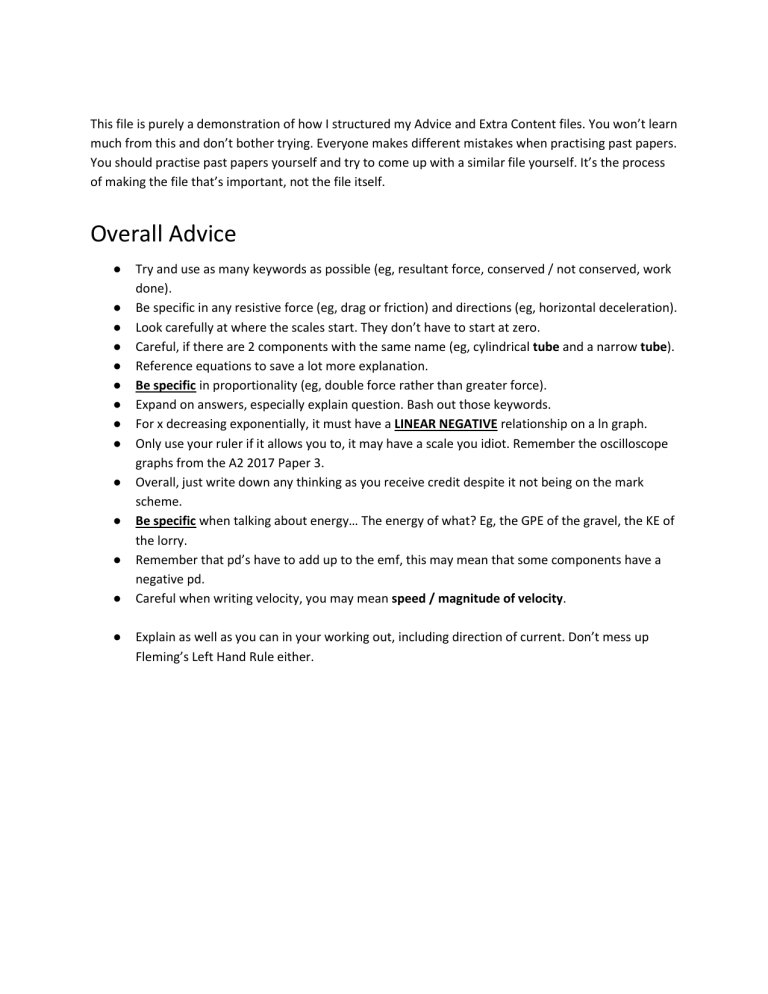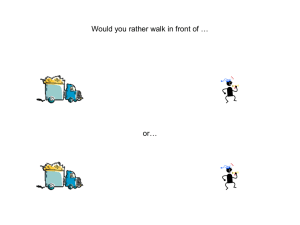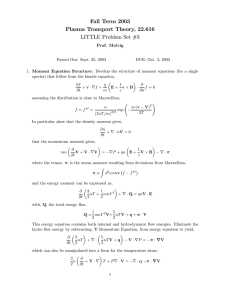
This file is purely a demonstration of how I structured my Advice and Extra Content files. You won’t learn much from this and don’t bother trying. Everyone makes different mistakes when practising past papers. You should practise past papers yourself and try to come up with a similar file yourself. It’s the process of making the file that’s important, not the file itself. Overall Advice ● ● ● ● ● ● ● ● ● ● ● ● ● ● Try and use as many keywords as possible (eg, resultant force, conserved / not conserved, work done). Be specific in any resistive force (eg, drag or friction) and directions (eg, horizontal deceleration). Look carefully at where the scales start. They don’t have to start at zero. Careful, if there are 2 components with the same name (eg, cylindrical tube and a narrow tube). Reference equations to save a lot more explanation. Be specific in proportionality (eg, double force rather than greater force). Expand on answers, especially explain question. Bash out those keywords. For x decreasing exponentially, it must have a LINEAR NEGATIVE relationship on a ln graph. Only use your ruler if it allows you to, it may have a scale you idiot. Remember the oscilloscope graphs from the A2 2017 Paper 3. Overall, just write down any thinking as you receive credit despite it not being on the mark scheme. Be specific when talking about energy… The energy of what? Eg, the GPE of the gravel, the KE of the lorry. Remember that pd’s have to add up to the emf, this may mean that some components have a negative pd. Careful when writing velocity, you may mean speed / magnitude of velocity. Explain as well as you can in your working out, including direction of current. Don’t mess up Fleming’s Left Hand Rule either. U1 - Measurements and their errors Extra Content This shows a reading of 1.85mm. The 1.5mm comes from the main scale and the 0.35mm comes from the screw. ● ● ● ● ● ● ● ● ● ● Vernier callipers are used for small sizes whereas micrometres are for even smaller sizes (like the diameter of a wire). A common improvement is just observing at right angles to avoid parallax error and thus systematic error. Eg, measuring from the bottom of the meniscus at eye-level. You can calculate the % uncertainty from 2 gradients by halving the range and dividing by the gradient of the LOBF. This is just like halving the range of values for tabulated data. Use a fiducial marker for both pendulums and springs. Measure across multiple fringes / swings / etc to reduce % uncertainty Measure along 3 different lines for a micrometer. Ue a heavy bob in a pendulum to reduce the effect of air resistance / damping. Remember that for describing practicals, you may have to draw a log or ln graph. Be specific when writing uncertainties, do you mean absolute or %? Keep track throughout the question such as the setting on the oscilloscope. Oscilloscopes ● ● Changing the time base from 0.5 ms to 0.2 ms will stretch the curve by 2.5 horizontally (2) which increases the resolution (1) so measuring across more divisions reduces uncertainty (1). ○ Nb, be quantitative whenever possible. When altering the y-gain from 1 V to 2 V, write “increases the voltages / div” or “reduce the sensitivity of the y-gain”. ● Remember that you can adjust the y vertical shift. Practical Skills ● ● ● Just use the 2 points you’re given to calculate the gradient. Your line of best fit is through these 2 points anyways (2018 Paper). Turn off the time base to easily see where the max emf is. Remember not to remove “anomalies” as radioactive decay is a random process. Search Coil Practical ● Ensure the search coil is in the centre of the slinky so you have the same flux density throughout it. Inverse Square Law ● ● ● You just have to be consistent in how you measure the lengths, eg, from the very edge of the source to the very edge of the GM tube. It is better to plot 1/C1/2 against x (distance from the detector) instead of 1/x2 since with the former, we can find the extra distance between the source and detector by extrapolating backwards to 1/C1/2 = 0. If you don’t get a straight line near the origin, it is usually because it isn’t a pure gamma emitter. Gas Laws ● ● For Boyle’s Law, you have to make sure you let the gas reach thermal equilibrium (room temperature) before reading each volume. For Charles’ Law, constant pressure is ensured with an open end. U2 - Particles and radiation Advice ● ● ● Draw the direction of the gauge bosons in any Feynman diagrams you draw. Use conservation laws to check any Feynman diagrams you draw. Look carefully at the axis for Feynman diagrams, the particles should never be going backwards in time. Doesn’t matter what you decide as being horizontal or vertical in time. Extra Content ● ● ● If the KE of colliding particles increases, heavier particles could be produced or ones with greater KE. For virtual photons, repulsion can be thought of as two people on roller skates passing a ball between them with each moving further back with each pass, whilst, attraction is like passing a boomerang. If you have a muon in an interaction then you'll have a muon neutrino produced too. U3 - Waves Advice ● ● ● ● ● SUPERPOSE is the word the specification wants you to use. If asked how the appearance of a spectrum will change and a different wavelength of light is used, mention colour! Using a dark room can help you calculate wavelength. If you’re saying that something is a wave (eg, electrons) then state what would happen if it were a particle. Be careful, point at nodes are created at the ends. Slap out those keywords. Extra Content ● ● ● ● ● Remember there is always some partial reflection when you have light being refracted (even along the boundary.). Draw this as a dotted line. Having too much tension on a string will mean its diameter decreases as it stretches so its mass per unit length decreases so the frequency of the first harmonic will increase. Touching a string ⅓ of the way along its length will force a minimum frequency of 3f where f is the frequency of the first harmonic. Increasing the distance between the diffraction grating and the screen leads to the spacing between maxima to increase as the angles in the triangles remain the same. Visualise it. Think of waves hitting a point from all the slits: ● Light bulbs and gunshots emit a range of different frequencies. U4 - Mechanics and materials Advice Mechanics ● ● ● ● You may have to consider the average height a block would move - as it isn’t a point. This is essentially what centre of mass is. Be careful as to what you take as the pivot. You should take where he is holding it as the pivot. Everything doesn’t work well. From Physics A2 Specimen P1, the pellet is embedded so it is a non-elastic collision so kinetic energy is lost so you have to use conservation of momentum instead. Now, if the pellet rebounds for steel block, greater change in momentum of pellet so greater change in momentum of the block. Block will have greater velocity (yet less mass) so will have greater energy (as velocity offsets slightly less mass) so will reach a greater height. Yet, for this case, you have more terms you need to solve (including bullet’s final velocity) so you have to assume the collision was elastic to do so which is unlikely as energy was put into deforming the bullet and producing sound. Mention explicitly that vertical and horizontal velocities are independent. The following question: Will have a change in momentum of... As you must remember you flip vectors when taking them away. Or, you can easily see that the change in momentum is to the right. ● Mention which force is horizontal which is vertical. Materials ● ● Remember that a spring’s elastic energy is transformed to both kinetic and gravitational potential. May have to divide by number of cables / springs in a cheeky question. Extra Content Mechanics ● ● You may well have no reaction force acting at a pivot (e.g., a bank) at the tipping point. Air resistance increases with speed. U5 - Electricity Advice ● ● ● REMEMBER KIRCHOFF’S LAWS, THEY MAKE LIFE MUCH EASIER. Look out for circuits containing diodes! Draw the correct equivalent resistance circuits: ● Work out the voltage between two points like this: ● Don’t use the power equation in which both values change, use it where one is fixed (may be due to a supply of 230 V). E.g., don’t use P = I2R if you know that R will affect I. For the V = E - Ir equation, state the gradient is the NEGATIVE of the internal resistance. Be specific in which direction the waveform is stretched in an oscilloscope. Compare the maximum power of a resistor to the power dissipated, if the latter is less then it is suitable. ● ● ● Extra Content ● ● ● ● ● ● For a superconductor resistance-temperature graph, there is an abrupt vertical fall when the temperature hits the critical. Read off any current-voltage graph they give you. Don’t try to force the use of any resistances (from lower voltages) when you clearly know resistance increases with voltage. You can alter the temperature of a thermistor by keeping it in a water bath (which is of constant temperature by stirring). Cells in series run out sooner than cells in parallel. More current flows through them so transfer more energy per second. Do not think of current as being constant and splitting up according to resistance. Current will change if resistances do too, they draw in as much current as they need. For example, if you have a thermistor in parallel with a resistor, a lower temperature means the thermistor’s resistance increases and less current will flow through it. This branch won’t affect the current in the other. AC supply if voltage goes negative and positive. U6 - Further mechanics Advice ● ● ● ● ● Consider what forces are directed towards and directed away from the centre of the circle to help find the centripetal force (i.e., the resultant force). Consider Fmax = uR (even though it isn’t on the syllabus). Consider the direction of motion and frictional force. Eg, if you’re finding the minimum velocity to stop you moving down the ramp, you have to consider friction acting up the ramp as it opposes the direction of motion. Consider normal forces more often. E.g., for you to feel weightless due to Earth’s rotation, you can use FCP = mg - FN and have FN = 0. For the paper cone ring question, it will be more heavily damped when oscillating without a ring as… Damping is caused by air resistance (1) metal ring has no effect on area (1) yet air resistance does work against the cone (1) and by 𝐸 𝑘 1 2 = 𝑚𝑣 2, less mass with the same work being done against the cone means greater speed loss. A heavier object will lose less speed. Extra Content ● When at the top of a loop, you will have a normal force acting downwards as the ‘floor’ is above you. It is due to electrostatic repulsion. Surfaces always push - never pull. However, if you’re analysing the track rather than the ball, you have a normal force upwards from the ball. ● You stay pinned to the wall in a rotor ride as... The centripetal force is provided by the reaction force (2). The faster it spins, the greater the centripetal force ∴ greater frictional force (1) ∵ Fmax = uR. Thus, the frictional force is equal to the weight (as they don’t move up or down) (1). The reaction force is due to inertia (you want to carry on in a straight line yet the walls push you back). In SHM, the fiducial marker is always at the centre because there is less uncertainty when it passes the point than if it was at the edges since it spends longer time at the edges and slows down and may not return to the same amplitude. Place whole set up in fluid to increase damping. ● ● U6 - Thermal physics Advice ● ● Rather than saying molecules move faster, say RMS speed increases, it’s better. When explaining why gas laws can be applied, say same mass of substance AND pressure/temp/vol constant. Extra Content ● To help remember what is kept constant in each gas law, use... U7 - Fields and their consequences Advice ● ● ● ● ● ● CHANGE IN FLUX and OPPOSE THE MOTION OF is a keyword, always write it for any electromagnetic induction question. When the current is constant, time constant isn’t really useful. Just consider the total charge delivered under this constant current. Working out energy losses as a capacitor discharges, calculate energy before and after. Don’t try your dumb fancy shortcut. When a magnet stops, its current doesn’t flip direction as it’s not moving backwards. When explaining why work is done to a positive charge in moving it to a point between 2 positive charges, you can simply write: potential at infinity = 0 and the potential at the point is positive. Look at field lines, don’t ignore them. More often than not, the information they provide is useful. ● Don't write greater attractive force but rather stronger field. Field strength stronger where more dense. Extra Content ● When the switch is closed, current flows via coil X producing flux through Y (1) current in Y flows opposite direction to create opposing flux (1), switching off flux via Y decreases flux causing current to flow in the opposite direction (1). ● The ammeter deflects then returns to zero as a change in flux (1) induces an emf (1) inducing a current. Then change stops. You can have situations where the electric field strength is zero but there is some electric potential (such as in the middle of a square with a charge of +Q at each vertex). Remember that electric potential is a scalar quantity so won’t cancel. Field lines and potential lines are always perpendicular: ● ● ● ● Pylon cables use 𝑃 = 𝐼 2 𝑅so need low resistance cables. As an ion is accelerated, the electric potential from the field goes to the kinetic energy of the ion. The power supply supplies energy to the field. U8 - Nuclear physics Advice ● ● ● ● You cannot treat a proton and neutron as the same when doing mass defect / binding energy calculations as you’ll be slightly off. Difference in binding energy is the energy released. Think about it, less energy is used in holding the atoms together. For decay diagrams, be careful whether you’re decaying from or decaying to. When describing a nuclear experiment, mention how to determine background count and safety precautions. Extra Content ● Something too old cannot be carbon-dated as the readings are small compared to background. U9 - Astrophysics Advice ● ● ● It can be useful to comment on all the star information they’ve given you. Any energy levels they draw may not necessarily be to scale. Look at the values. During redshift calculations, it’s better to ignore the sign then take it into account later based off the data in a calculation. Just calculate Δf then add or subtract. ● Remember to compare the size of object from minimum resolution to the object size. Extra Content ● ● ● You can use Stefan’s Law to justify why one star is larger than the other. Eg, same spectral class so similar temperature (1) brighter absolute magnitude means greater power (1) to have greater power, need larger SA (1). You can calculate how much one pixel will be and compare it to the diameter of the object so determine how much you will be able to see. Telescopes in orbit need their own power source and are difficult to repair compared to groundbased ones.



